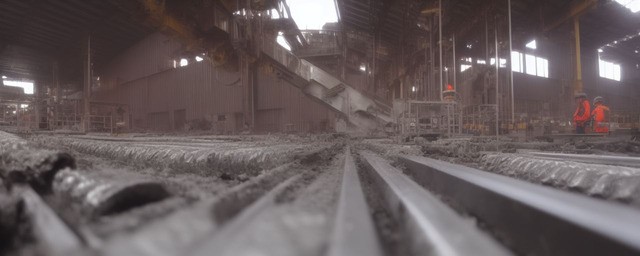
钢铁是怎样炼成的英文
原|2023-12-21 12:37:55|浏览:93
How Steel is Made
Steel is one of the most widely used materials in the world, with applications ranging from construction and manufacturing to transportation and energy. It is a strong and durable material that is essential in modern society. But how is steel actually made In this essay, we will explore the process of making steel, from raw materials to the final product.
The process of making steel starts with the mining of iron ore. Iron ore is a rock that contains iron in various forms, such as magnetite, hematite, and siderite. The ore is then crushed and processed to remove impurities and increase the iron content. This process is known as beneficiation. The resulting iron ore concentrate is then transported to a steel mill, where it will undergo further processing.
At the steel mill, the iron ore concentrate is mixed with limestone and coke (a carbon-rich material derived from coal) in a blast furnace. The purpose of adding limestone is to remove impurities, such as silica and alumina, while the coke provides the necessary heat and carbon to facilitate the chemical reactions. The mixture is then heated to extremely high temperatures, reaching up to 2,700 degrees Fahrenheit.
Within the blast furnace, several chemical reactions take place. Firstly, the carbon in the coke reacts with oxygen in the air to produce carbon monoxide gas. This gas then reacts with the iron oxide in the ore to form liquid iron and carbon dioxide gas. The liquid iron, also known as pig iron, collects at the bottom of the furnace, while the carbon dioxide gas is released into the atmosphere.
The pig iron obtained from the blast furnace is not suitable for most applications due to its high carbon content. Therefore, it needs to be further processed to transform it into steel. This is done in a basic oxygen furnace (BOF) or an electric arc furnace (EAF).
In the BOF process, the pig iron is combined with scrap steel and flux, which helps remove impurities. Pure oxygen is then blown into the converter, causing the impurities to react with the flux and form a slag. The slag is then removed, and the remaining liquid metal is further refined to achieve the desired composition and properties. This process is known as steelmaking in a basic oxygen furnace.
Alternatively, the electric arc furnace process can be used. In this method, scrap steel and/or direct-reduced iron (DRI) are melted using an electric arc. This process is more flexible than the BOF process, as it allows for a wide range of inputs and produces a higher quality of steel. However, it is also more energy-intensive.
Once the steel has been refined, it can be cast into various shapes, such as slabs, blooms, or billets, depending on the final product specifications. These shapes can be further processed through rolling mills, where they are shaped into the desired form, such as sheets, bars, or rods. Additional processes, such as heat treatment or surface finishing, may also be applied to enhance the properties and appearance of the steel.
In conclusion, the process of making steel involves several stages, from mining and processing iron ore to refining the pig iron into steel. It is a complex and highly controlled process, requiring different equipment and techniques. Steelmaking is a crucial industry that contributes to the development and progress of society, providing the raw material for countless applications in various sectors.
猜你喜欢
- 茶的分类及代表品种
- 六大茶类的代表名茶分别有
- 茶的类型和代表
- 六大茶叶的分类及产地
- 庙的分类及代表
- 藻的分类及其代表
- 茶的分类及代表茶品特点
- 茶的分类及代表茶
- 简述茶类的分类及其代表性名茶
- 六大茶类的分类及代表茶
- 动物分类及代表
- 糖的分类及代表
- 茶的分类及代表茶叶
- 茶的分类及代表图
- 茶的分类及代表作
- 茶器按质地的分类及代表茶器
- 茶的分类及代表名茶教学设计
- 简述茶的分类及代表性名茶
- 请写出乌龙茶的分类及代表茶
- 法国雅文邑白兰地系列
- 雅文邑白兰地介绍
- 1952年法国雅文邑白兰地
- 法国雅玛邑白兰地
- 纽波利顿獒
- 法国犬品种
- 南非獒犬的优缺点
- 波尔多獒犬寿命
- 波兰狩猎犬
- 波尔多犬和罗威纳犬对比
- 波尔多犬和杜高对比
- 世界十大凶犬
- 护卫犬排行榜前十名
- 大红袍怎么泡效果好
- 大红袍怎么泡不开
- 大红袍怎么泡茶
- 大红袍怎么泡出来没颜色
- 大红袍怎么泡不苦
- 大红袍怎么泡多久
- 大红袍怎么泡才正确的特点
- 大红袍怎么泡没有柴味儿
- 大红袍怎么泡放多少合适
- 花香大红袍怎么泡
- 大红袍怎么泡茶好
- 大红袍是怎么泡的
- 大红袍怎么泡水好喝
- 大红袍用玻璃杯怎么泡
- 大红袍怎么泡味道浓一些
- 十大排名果花茶
- 十大花茶组合排名
- 十大花茶品种大全
- 十大花茶功效
- 十大花茶销量排行榜
- 十大花茶有哪些
- 十大花茶品种
- 十大花茶推荐
- 十大花卉排行榜
- 十大花卉
- 十大花茶调理内分泌
- 九五至尊秦昊明月关山
- 红茶冲泡工艺
为你推荐






































































